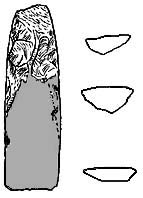
back *****************VOLUME 17 page 4 ***************** next page
Recent Discoveries
*****On a more recent review of this same area I found a complete (however broken) medium sized fishhook, this I have illustrated in Diagram 17.2. Again it must be remembered that there is no way of knowing whether or not this hook is old or new, however I suspect that it will prove to be a very important early type. On the other hand about 50 meters closer to the shoreline I discovered yet another nearly complete, medium sized fishhook. In form it is much more like the later hooks found in the Marquesas and New Zealand, see Diagram 17.3. A small fishhook blank was found near the boundary between ATIAHARA #5 and #6, this blank shows very minute traces of initial drilling on the back, I have reproduced this specimen in Diagram 17.10.
*****One of the most productive sites, in terms of fishhooks, and or fishing related artifacts, is AHOAPOFATU #1, it has been recently ploughed and extended. Here I was very pleased to find yet another complete fishhook, this specimen has been fashioned from Turbo-shell and is thus a very rare and miraculous find, considering the fragility of Turbo. This hook may be an important link to the Hawaiian collection and it is illustrated in Diagram 17.4. and the Comparative Diagram 17.6 where I have also included illustrations of other small hooks from the AHOAPOFATU site. There appears to be a considerable amount of uniformity in certain of these small hooks. The Pearl-shell example quite comparable to the Turbo-shell model, these in turn show a certain correspondence with New Zealand shell hooks (see Comparative Diagram 17.14). Also I have assembled most of the small fishhooks and or fishhook blanks on one page, Diagram 17.12) for further comparative study.
*****Also found recently at AHOAPOFATU #1, a large fishhook blank, (in many pieces, see Diagram 17.11) as well as a medium sized blank and an unusually shaped fragment, these are to be found illustrated in Diagram 17.5. The large blank showing signs of the first initial drilling processes, may be of considerable diagnostic importance, while its overall size and form further add to its value in comparative studies.
*****Three more complete adzes were found at ATIAHARA #5, these show the full range of the occupation of this site, one being an exceptionally well made (pecked) modern 3Aa and another a very ancient looking small 2Aa which is unpecked and well patinated, these I have illustrated in Diagrams 17.17 and Diagram 17.18. The Schubert team recovered a well pecked, horned 1Aa fragment as well as a very primitive unfinished 1A fragment. Both of these specimens being found from the southwest corner (see also Diagram 17.20). These fragments compare well with a another Tubuai IA adze which was found in a private collection, and has been reproduced in Diagram 17.19. One of the most important breakthroughs in the search for the origins of the Early East Polynesian Culture, will be establishing the source of the first 1A adzes. The 1A adze fragment illustrated in Diagram 17.20 may be one of Tubuai's earlier examples. (See also Volume 7, Figure 14, Adze Type 1A from the A. Viriamu Collection, another early example of a similar size.)
Return to the top of the page